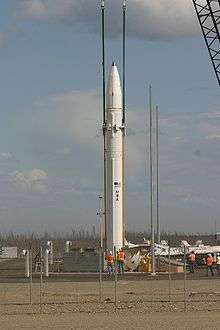Ground-Based Interceptor
| Ground-Based Interceptor | |
|---|---|
 A Ground-Based Interceptor loaded into a silo at Fort Greely, Alaska, in July 2004 | |
| Type | Anti-ballistic missile |
| Place of origin | United States |
| Service history | |
| Used by | United States Army |
| Production history | |
| Manufacturer | Orbital Sciences Corporation, Raytheon, Boeing Defense, Space & Security |
| Specifications | |
| Weight | 21,600 kg [1] |
| Length | 16.61 m [1] |
| Diameter | 1.28 m [1] |
|
| |
| Propellant | solid-fuel |
The Ground-Based Interceptor is the anti-ballistic missile component of the United States' Ground-Based Midcourse Defense (GMD) system. This interceptor is made up of a boost vehicle, constructed by Orbital Sciences Corporation, and an Exoatmospheric Kill Vehicle, built by Raytheon. Integration of these is performed by Boeing Defense, Space & Security.[2]
The boost vehicle uses the solid-fuel rocket upper stages of the Taurus launcher.[3] The interceptor version deployed in the U.S. has three stages. A two-stage version was successfully tested in 2010 for use in Europe's NATO missile defence as a backup option to the preferred Aegis System Standard Missile 3.[4]
As of 2013, 26 interceptors were deployed at Fort Greely, Alaska, with an increase to 40 planned by 2017.[5]
References
- 1 2 3 Jim O'Halloran (15 Jan 2014). Jane's Weapons 2014/2015: Strategic (PDF). Jane's Information Group. p. 243. ISBN 978-0710631077.
- ↑ "Fact sheet: GMD Boost Vehicle" (PDF). Orbital Sciences Corporation.
- ↑ William Graham (27 June 2013). "Orbital's Pegasus XL successfully lofts IRIS spacecraft". NASA.
The Orbital Boost Vehicle, developed for the US military’s Ground Based Interceptor program, uses the upper stages of the Taurus
- ↑ Turner Brinton (June 7, 2010). "Two-Stage Interceptor Missile Succeeds in First Flight Test". Space News. Retrieved February 8, 2015.
- ↑ Tim Ellis (18 December 2013). "Greely Missile-Defense Base Prepares For More Interceptors". Alaska Public Media.